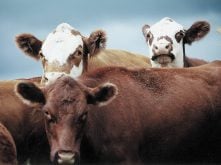This cattle market information is selected from the weekly report from Canfax, a division of the Canadian Cattle Association. More market information, analysis and statistics are available by becoming a Canfax subscriber by calling 403-275-5110 or at www.canfax.ca.
Fed market rises
Over the past three months, the fed market has been stuck in a five-dollar trading range ($240-$245 per hundredweight). The market has finally broken to the upside, hitting the highest point since mid-August.
Read Also

Government support for Canadian farmers has plummeted
Subsidies in Canada were 30 per cent of gross farm receipts in 1980s and are now around eight per cent
Last week, dressed sales were reported from $405-$408/cwt delivered. Buying interest was noted from three different U.S. packers with light to moderate volumes of western Canadian fed cattle marketed south. Sales to the U.S. were at a premium over local deals.
Despite historically light cow slaughter volumes, packers have been reluctant to allocate more hours to youthful cattle. Over the past four weeks, western Canadian fed slaughter has averaged 39,888 head per week, seven per cent below last year. Western Canadian steer carcass weights averaged 985 pounds, 14 lb. shy of records set in December 2023.
Dressed sales in Ontario were reported at $411/cwt delivered, steady with the previous week. Fed calf supplies are seasonally declining, while yearling numbers will likely be slow to increase. This should be price supportive in the near term.
In the U.S., dressed sales in northern feeding states were from US$290-$292/cwt, fully steady with the previous week. Live sales in Nebraska were reported from $186-$187/cwt, steady to $2/cwt higher.
For the week ending Nov. 9, U.S. beef cow slaughter was just over 59,000 head, 26 per cent lower than last year. For the beginning of November, this is the smallest cow slaughter since 2016. Five-year averages show beef cow slaughter volumes usually peak during the first half of November.
Cull price lowers
Alberta cull cows and butcher bulls through commercial auction marts closed last week around $2/cwt softer. Feeder cows were $6/cwt stronger, while railgrade cows were steady with a slightly stronger tone.
D2s averaged $168.89/cwt and D3s averaged $157.98. Butcher bulls averaged $187.66/cwt.
From a historical perspective, cull prices put in a low the last week of November and move higher to end the year.
In Ontario, D2 cows were $2/cwt stronger than the previous week, while D3 cows were $3/cwt softer. Last week, Alberta D2 cows were at a $21/cwt premium to the Ontario market, the second widest since the first week of July. Alberta D3 cows were at a $37/cwt premium to Ontario, the widest since the first half of June.
Western Canadian non-fed slaughter for the week ending Nov. 16 was just shy of 6,800 head, the largest weekly slaughter volume since the end of April. Western Canadian cow carcass weights averaged 779 lb., 41 lb. heavier than the same week last year.
Year to date, cow carcass weights at 809 lb. are 49 lb. heavier than last year. Eastern Canadian non-fed slaughter for the week ending Nov. 16 was just shy of 2,500 head, the largest weekly volume since the last week of January.
Cutouts rally
In U.S. beef trade, Choice cutouts rallied higher last week on last minute Thanksgiving buying, while Select cutouts continued to ease lower. Choice cutouts closed the week up one per cent to US$306.79/cwt, while Select was 1.5 per cent softer at $272.92/cwt.
Fall run winds up
Alberta auction volumes were 54,198 head, the first time in four weeks they have fallen below the five-year average. As the fall run wraps up, auction volumes are expected to further decline into December.
Last week, calves and stockers traded $1-$17/cwt stronger with only 800-900 lb. steers trading $3.43/cwt softer than the previous week. The fall run made a low in the third week of September, touching last year’s peak. Over the past decade, only 2014 and 2020 recorded price rallies this late into the year.
Calves weighing 500-600 lb. saw the biggest rally last week, trading $12.44-$17.28/cwt higher than the previous week, setting new annual highs at $455/cwt for steers and $416/cwt for heifers.
The nearby January feeder cattle contract rallied $9.12/cwt from Nov. 14 to Nov. 20.
As the bred female market heats up, bred heifers traded $621.94/head stronger than the previous week, averaging $4,702/head.
For the week ending Nov. 9, feeder cattle exports to the U.S. were 3,587 head, down 13 per cent from last year. This is the 21st consecutive week of lower exports compared to a year ago. Year to date feeder exports are now 12 per cent lower than last year at 137,040 head.














